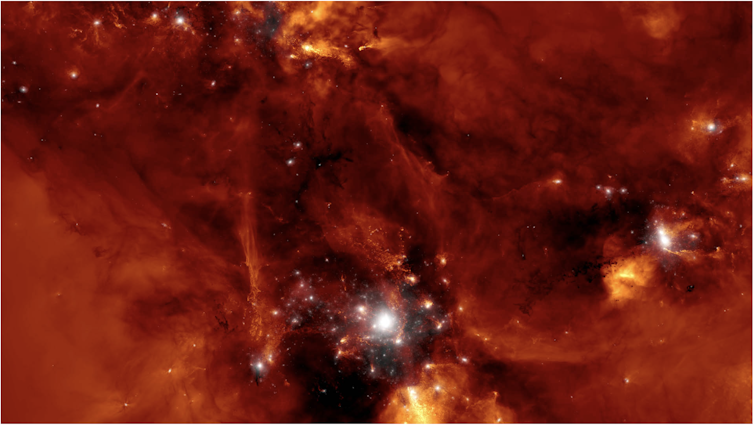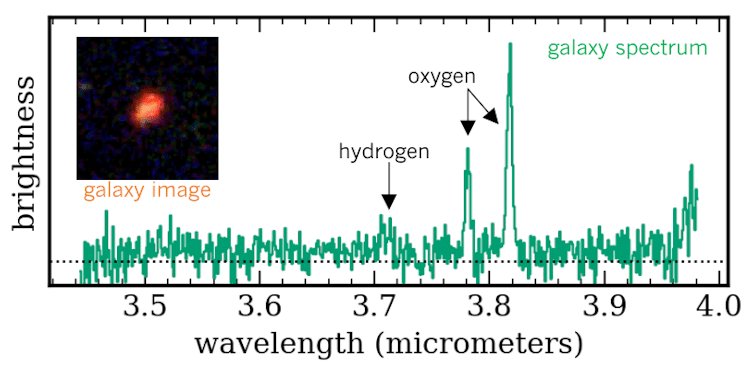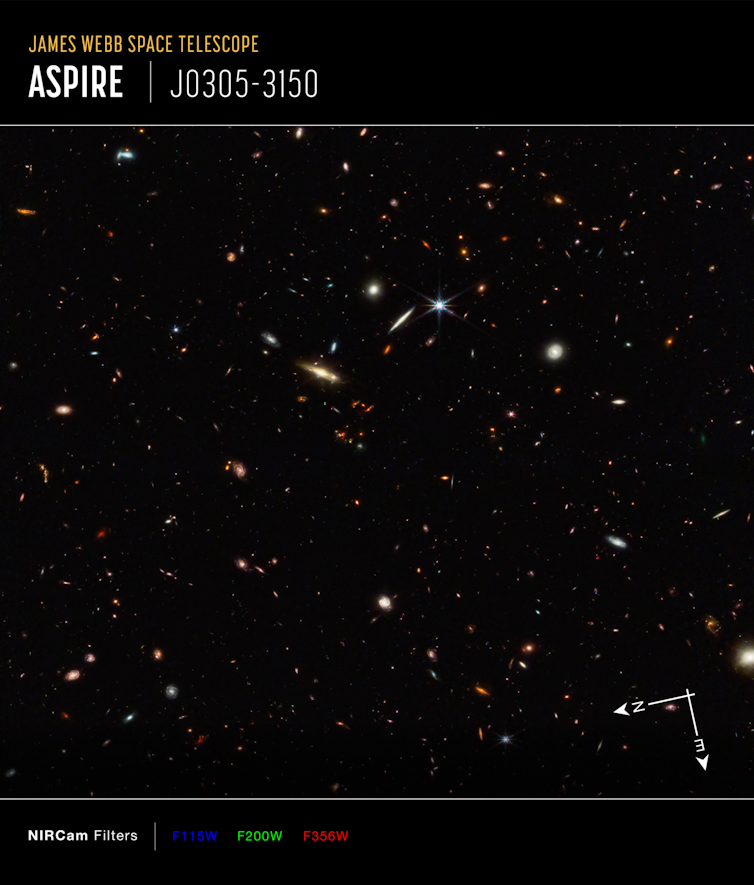Science
Powerful black holes might grow up in bustling galactic neighborhoods

International Gemini Observatory/NOIRLab/NSF/AURA/P. Marenfeld, CC BY-NC-SA
As people, we are all shaped by the neighborhoods we grew up in, whether it was a bustling urban center or the quiet countryside. Objects in distant outer space are no different.
As an astronomer at the University of Arizona, I like to think of myself as a cosmic historian, tracking how supermassive black holes grew up.
Like you, every supermassive black hole lives in a home – its host galaxy – and a neighborhood – its local group of other galaxies. A supermassive black hole grows by consuming gas already inside its host galaxy, sometimes reaching a billion times heavier than our Sun.
Theoretical physics predicts that black holes should take billions of years to grow into quasars, which are extra bright and powerful objects powered by black holes. Yet astronomers know that many quasars have formed in only a few hundred million years.
I’m fascinated by this peculiar problem of faster-than-expected black hole growth and am working to solve it by zooming out and examining the space around these black holes. Maybe the most massive quasars are city slickers, forming in hubs of tens or hundreds of other galaxies. Or maybe quasars can grow to huge proportions even in the most desolate regions of the universe.
Galaxy protoclusters
The largest object that can form in the universe is a galaxy cluster, containing hundreds of galaxies pulled by gravity to a common center. Before these grouped galaxies collapse into a single object, astronomers call them protoclusters. In these dense galaxy neighborhoods, astronomers see colliding galaxies, growing black holes and great swarms of gas that will eventually become the next generation of stars.
These protocluster structures grow much faster than we thought, too, so we have a second cosmic problem to solve – how do quasars and protoclusters evolve so quickly? Are they connected?

TNG Collaboration, CC BY-NC-SA
To look at protoclusters, astronomers ideally obtain images, which show the galaxy’s shape, size and color, and a spectrum, which shows the galaxy’s distance from Earth through specific wavelengths of light, for each galaxy in the protocluster.
With telescopes like the James Webb Space Telescope, astronomers can see galaxies and black holes as they were billions of years ago, since the light emitted from distant objects must travel billions of light-years to reach its detectors. We can then look at protoclusters’ and quasars’ baby pictures to see how they evolved at early times.

J. Champagne/ASPIRE/University of Arizona
It is only after looking at spectra that astronomers determine whether the galaxies and quasars are actually close together in three-dimensional space. But getting spectra for every galaxy one at a time can take many more hours than any astronomer has, and images can show galaxies that look closer together than they actually are.
So, for a long time, it was only a prediction that massive quasars might be evolving at the centers of vast galactic cities.
An unprecedented view of quasar environments
Now, Webb has completely revolutionized the search for galaxy neighborhoods because of an instrument called a wide-field slitless spectrograph.
This instrument takes spectra of every galaxy in its field of view simultaneously so astronomers can map out an entire cosmic city at once. It encodes the critical information about galaxies’ 3D locations by capturing the light emitted from gas at specific wavelengths – and in only a few hours of observing time.
The first Webb projects are hoping to look at quasar environments focused on a period about 800 million years after the Big Bang. This time period is a sweet spot in which astronomers can view these monster quasars and their neighbors using the light emitted by hydrogen and oxygen. The wavelengths of these light features show where the objects emitting them are along our line of sight, allowing astronomers to complete the census of where galaxies live relative to bright quasars.
One such ongoing project is led by the ASPIRE team at the University of Arizona’s Steward Observatory. In an early paper, they found a protocluster around an extremely bright quasar and confirmed it with 12 galaxies’ spectra.
Another study detected over a hundred galaxies, looking toward the single most luminous quasar known in the early universe. Twenty-four of those galaxies were close to the quasar or in its neighborhood.

STScI/NASA
In ongoing work, my team is learning more details about mini galaxy cities like these. We want to figure out if individual galaxies show high rates of new star formation, if they contain large masses of old stars or if they are merging with one another. All these metrics would indicate that these galaxies are still actively evolving but had already formed millions of years before we observed them.
Once my team has a list of the properties of the galaxies in an area, we’ll compare these properties with a control sample of random galaxies in the universe, far away from any quasar. If these metrics are different enough from the control, we’ll have good evidence that quasars do grow up in special neighborhoods – ones developing much faster than the more sparse regions of the universe.
While astronomers still need more than a handful of quasars to prove this hypothesis on a larger scale, Webb has already opened a window into a bright future of discovery in glorious, high-resolution detail.![]()
Jaclyn Champagne, JASPER Postdoctoral Researcher, University of Arizona
This article is republished from The Conversation under a Creative Commons license. Read the original article.





















